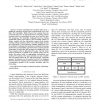Free Online Productivity Tools
i2Speak
i2Symbol
i2OCR
iTex2Img
iWeb2Print
iWeb2Shot
i2Type
iPdf2Split
iPdf2Merge
i2Bopomofo
i2Arabic
i2Style
i2Image
i2PDF
iLatex2Rtf
Sci2ools
CLUSTER
2009
IEEE
2009
IEEE
Scalable I/O forwarding framework for high-performance computing systems
—Current leadership-class machines suffer from a significant imbalance between their computational power and their I/O bandwidth. While Moore’s law ensures that the computational power of high-performance computing systems increases with every generation, the same is not true for their I/O subsystems. The scalability challenges faced by existing parallel file systems with respect to the increasing number of clients, coupled with the minimalistic compute node kernels running on these machines, call for a new I/O paradigm to meet the requirements of data-intensive scientific applications. I/O forwarding is a technique that attempts to bridge the increasing performance and scalability gap between the compute and I/O components of leadership-class machines by shipping I/O calls from compute nodes to dedicated I/O nodes. The I/O nodes perform operations on behalf of the compute nodes and can reduce file system traffic by aggregating, rescheduling, and caching I/O requests. This pap...
| Added | 20 May 2010 |
| Updated | 20 May 2010 |
| Type | Conference |
| Year | 2009 |
| Where | CLUSTER |
| Authors | Nawab Ali, Philip H. Carns, Kamil Iskra, Dries Kimpe, Samuel Lang, Robert Latham, Robert B. Ross, Lee Ward, P. Sadayappan |
Comments (0)

